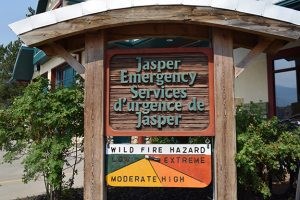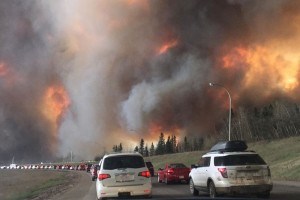
As hundreds of wildfires burn across British Columbia and extreme fire conditions take hold in Jasper National Park the municipality is reminding residents and visitors to be prepared in the event of an emergency.
According to Parks Canada, the current fire danger in JNP is hovering between high and extreme and the weather forecast doesn’t look promising.
“It’s always hard to tell what is going to happen so far in advance, but most of the weather models are predicting we have another three to five days of hot and dry weather ahead of us,” said Dave Smith, a fire and vegetation specialist for Parks Canada.
“Whenever we have hot and dry weather it means there’s a likelihood that we’re going to get some convective activity so in other words we’re going to see a lot of movement in the air going upwards and when that happens we have the potential for developing thunderclouds and lightning, which is one of the ways fires are ignited.”
Should a wildfire start in Jasper he said Parks Canada has a helicopter and a four-man initial attack crew on standby.
“When we have these conditions the initial attack crew is on extended hours and they are what we call on high alert,” Smith said, adding the helicopter is also patrolling the park looking for smoke.
He urged anyone who may think they see smoke to call 911 immediately so they can assess the situation and confirm whether there’s a fire or not.
To date the fire crew has only had to deal with one small fire near Snaring River and Highway 16 on July 7. The fire is believed to have been started by construction workers in the area and was quickly extinguished.
Smith said residents and visitors should not be concerned about the smoke that has blanketed Jasper in recent days, unless they have respiratory issues.
“The smoke is coming from very far away,” said Smith. “We have some very big fires in B.C. so because there is so much convective activity associated with those hot fires it’s pushing the smoke way up into the upper atmosphere and that’s why we’re seeing so much smoke.”
On July 10 Alberta Health Services issued a precautionary air quality advisory for the Jasper, Hinton and Edson areas.
According to the provincial agency, the air quality in the region is expected to be variable over the coming days and potentially weeks.
“If it does get really smoky people who have respiratory issues should consider staying inside, but the smoke should be nothing more than an irritant to see our beautiful mountains,” said Smith.
He said at present time there are no plans to put a fire ban in place.
“It is a possibility, we’ve talked about it, but we’re not there yet,” said Smith.
“That being said we always have a fire ban in Jasper. When we hear about fire bans out in the province what they’re focusing on is people having illegal fires in random campsites and people burning their garbage, that sort of thing. In a national park there is only place that you’re legally allowed to have a fire and that’s in a designated fire pit.”
Mayor Richard Ireland said the best thing people can do is to be prepared in the event of an emergency.
“The greatest message right now and you see it throughout B.C. is be prepared to look after yourselves, your pets and your family members for at least several days,” said Ireland.
The municipality advises people to have an emergency kit prepared with basic supplies to last 72 hours. This kit should include emergency food and water, first-aid supplies, a flashlight, portable radio, clothes and personal items such as medicine, identification and money.
It is also important to have a full tank of gas.
Increasing the wildfire risk this year are the number of dead pine trees affected by the mountain pine beetle.
“What we find with dead trees associated with the mountain pine beetle is when there is a fire there is the potential for the intensity to be higher, but with these conditions we have right now, whether we have mountain pine beetle or not, the forests are tinder dry and would burn very hot at a high intensity,” said Smith.
He said trees affected by the mountain pine beetle are a bigger concern when the park is at a lower fire danger because the dead trees increase the amount of dry fuels.
“Our danger is based on the weather, but it’s also based on the fuel moisture content, or how dry the fuels are and whether they are dead or alive everything is very dry and very volatile right now,” said Smith.
Ireland said the increased risk is even more reason to be prepared and said it as a public safety issue.
It’s become such a concern for local leaders MP Jim Eglinski brought it up in the House of Commons on June 16.
Environment Minister Catherine McKenna said her government was working hard in all of the country’s national parks, including Jasper and welcomed further discussion about the issue with Eglinski at a future date.
Paul Clarke
[email protected]

